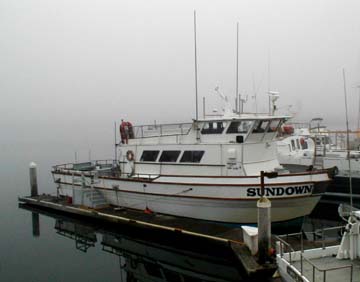
Our Island Packers boat to Santa Cruz Island
Continued
West Santa Cruz Island
The trip to West Santa Cruz Island took longer, and the boat was bigger with more inside space.

We packed overnight packs for the island, and day packs for the multi-hour crossing to the island. We also had to bring our own water, in the 3.5 gallon blue plastic jug. Island Packers required each pack to be under 40 pounds. The gasoline for our cookstove was kept out of the packs and stored in a separate open bucket on deck. On the crossing the boat hit some large waves which turned over the bucket full of gas bottles, they skittered around on the deck, I made a dive for ours and saved it before it slid overboard through one of the drain ports. Whew!
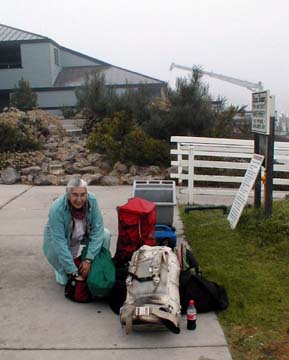
We stayed outside as much as possible to watch for dolphins. Dozens of common dolphins came around the boat to play in our bow wave and wake. Half-way across the channel we were greeted by a family of 3 humpback whales. They put on a good show for us, blowing and breathing, arching their humped backs as they dove. It was my first encounter with a humpback whale so it was a special crossing. The naturalist on board gave us guidance on what to watch for in the behavior of the whales and dolphins. Island packers did a great job getting us to the islands and back aain, I recommend them, and will use them again on my next trip to the islands.
We arrived at the beautiful harbor at West Santa Cruz Island. Notice how clear the water is. There is great snorkeling right off the dock, but bring a wetsuit, the water is under 60 F. The boat backs into the dock, visitors climb up a short ladder. A ranger greets each boat with island information.
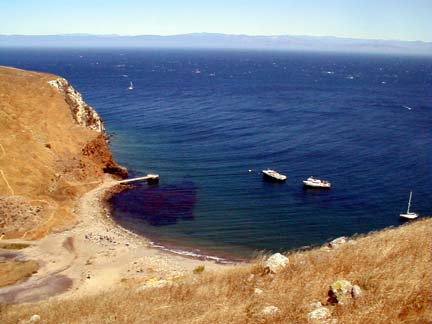
We hiked in to the campsites. The campsites nearest the boats were a 1/2 mile walk, but we had packed all our gear in backpacks so it was an easy walk. The near campsites had been recently excavated to install a septic field, but the further campsites were full of an organized youth group we voted for the septic field and it was the correct choice. We unpacked our gear and ate lunch.

(We've had our Moss tent for over a decade and it has served us well, but the Moss company has new owners and Martin reports that his 1997 tent has had one failed seam after another, he's going to buy a new tent from another company soon.)
Someone in our crew misunderstood what a bear can was for...Bear cans are used to protect food from bears and rodents, they are not for carrying bears!
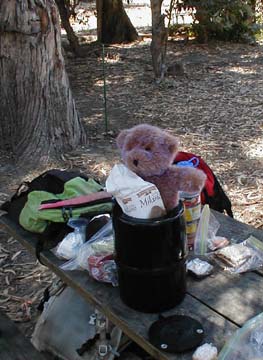
After lunch we met the ranger who told us tales about the island. In the last year they had captured over 10,000 sheep alive on the island and shipped them to shore. At one time there had been 40,000 sheep, now they think there are none. It sounded like quite a job catching and moving sheep. Next they had to eradicate the wild pigs, no hint of live capture here. Then the island could start healing after decades of over grazing. He pointed out the multiple landslides on the island, the result of el nino on top of the heavy grazing. During the el nino year, 1998, they had a flood that delivered a years worth of rain in one night. He recommended some trails and so we set out to see the island.
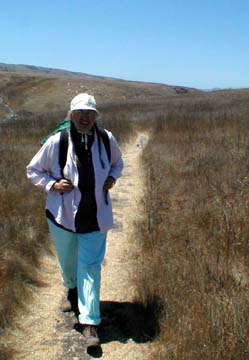
Along the trail the vegetation was mostly dry and brown due to the lack of rain each summer. One succulent plant was in bloom however. Its white flowers gleamed amid the hairy fat leaves and wonderful dew-like sparkles of spherical droplets on the leaves.
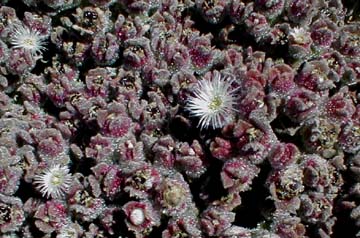
At the end of the trail we came to another harbor. The wind was blowing straight into this harbor so it provided no shelter.
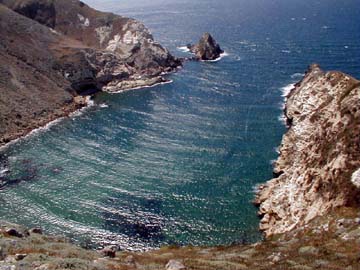
After hiking to the end of the trail along the north coast Ellen suggested I might like to bushwhack back to camp following the streambed through a canyon. Indeed I would so I set off cross country. The unofficial use trail soon faded to animal tracks that took me down into the canyon. I was in a world of small cliffs of volcanic rock, the stream bed provided a nice hiking route.
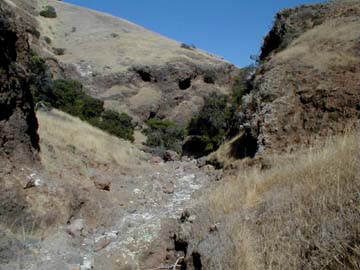
That night we could hear the enthusiastic partying from the youth group a quarter mile away. Luckily they got quiet shortly after dark. We also spotted one of the feral pigs, it was quite large and unafraid of people. The pigs act as living rototillers to root out plants, the park service plans to elimimate the pigs then replant the island with native plants. I wonder how the island will look in a hundred years?
|
Scientific Explorations with Paul Doherty |
|